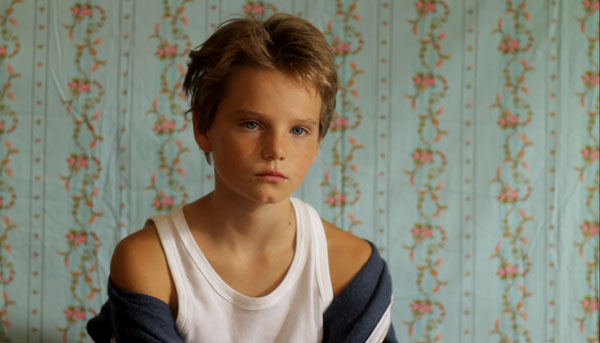
Zoé Heran as Laure/Mikael Tomboy_Rocket Releasing © Hold Up Films
Rarely does a film succeed in rendering the world of a child from a child’s point of view. Too often, the filmmaker’s perspective, de facto adult, prevails. The portrait of childhood that results is tinged with sepia tones, as if all children possessed a preternatural awareness of their impending loss of innocence, years before the fact. Washed in the nostalgia of grown-ups, such films strip children of complexity and quirk, flattening them into figures who inspire a mix of melancholy and self-pity.
Céline Sciamma’s film Tomboy successfully avoids these tendencies. At once sincere and free of sentiment, Sciamma’s sophomore feature effort (after her 2007 debut, Water Lillies) delivers a vignette of childhood whose subtlety eschews cliché and easy explanation. The film follows Laure, the ten-year-old “tomboy” of its title, who moves with her parents and younger sister to Noisiel, an eastern suburb of Paris, in the early months of summer. Laure’s family harbors few reservations about her boyish demeanor: her mother, genial and heavily pregnant, spends most days supine in bed, while her father works during the week. Laure is left to play with six-year-old Jeanne, an ebullient and decidedly more “girly” girl. When Laure first encounters a child of her own age, a girl named Lisa, she find she is mistaken for a boy. “T’es nouveau?” — “Are you new?” — Lisa queries, using the masculine “nouveau” instead of the feminine “nouvelle.” Rather than correct Lisa’s error, Laure plays along, deeming herself “Mikael” and endeavoring to play the authentic boy.
Portrayed by French actress Zoé Heran, Laure easily passes for a member of the opposite sex, even when she’s not consciously acting the part. Tomboy opens with a low-angled close-up of the back of Laure’s head, level against a verdant background blurred by motion. Hair cropped and clad in a blue T-shirt, the child on the screen seems unambiguously male. The camera cuts to a shot of the sun flitting through treetops, then to a close-up of Laure’s hand wafting in the breeze. The soft hum of tire against road alerts us to the fact that we are looking out of the roof of a car, and the camera jumps to a close-up of Héran’s face drifting up and down in the air, her eyes closed as if in meditation. Laure has been immediately aligned with nature, the realm of raucous boyhood, far from the domestic spaces conventionally occupied by girls. Indeed, during the film’s first scenes, Sciamma gives no indication that Laure’s identity is other than Mikael. Only fifteen minutes into the film do we realize that Laure is leading a double life, when she rises from the bathtub, fully nude.
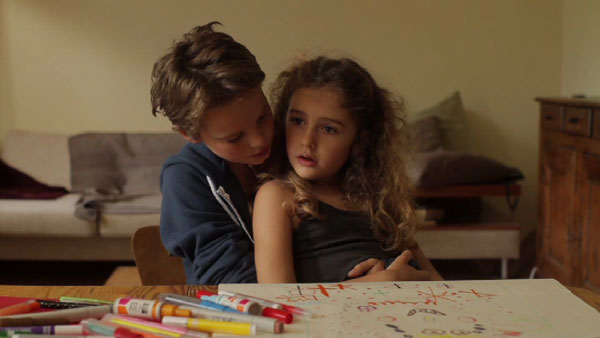
Zoé Heran as Laure/Mikael & Malonn Lévana as Jeanne Tomboy_Rocket Releasing © Hold Up Films
Sciamma’s direction deftly cues the viewer to redouble Lisa’s mistake, most obviously by employing a binary color scheme, where blue means boys and red means girls. As Laure wanders through her new home, she passes through a blue-walled bedroom — hers, we learn in the ensuing scene — then moves into a red-curtained room, where her sister lies atop a pink comforter. Jeanne, the film’s only character to abide by the unspoken covenants of girlhood, hews to her bedroom’s palette. Laure, who straddles both genders, always sports an item of either color and at times dons both at once: A blue sweatshirt, a red bathing suit, or red shorts with a blue tank. Laure’s friend and burgeoning love interest, Lisa, is associated with the composite of blue and red, purple: She is twice costumed in a lavender tanktop and the walls of her apartment’s foyer, highlighted in the movie’s climatic scene, are mauve. These blendings befit Lisa’s attraction to Mikael’s feminized brand of masculinity, at once sensitive and aggressive.
Sciamma’s sensibility is minimalist, her cinema more inclined to delete than to add. Dialogue is one of Tomboy’s principle excisions, its absence most extreme in moments of peak dramatic tension, where conversation dulls or disappears altogether. Laure is an unusually laconic child: Unable to express feelings verbally, she renders them through discreet facial expressions — an upturn of the lips here, a wrinkle of the nose there. Absent histrionics, Laure’s restrained emotional palette leaves her interiority somewhat opaque. Rather than dictate emotion, Sciamma’s subtle and agile direction allows us to attempt our own judgment about Mikael, whether he may be a passing phase or something more serious.
Laure manages to transcend the constrictions of gender, at least for a summer. Other characters are not so free. When the boys suggest a game of soccer, Lisa replies with a groan: “It’s boring!” In response, one of the boys smartly suggests that she play the cheerleader. “I don’t have a choice,” Lisa confides to Laure. “They don’t want me to play. They say I stink.” In Sciamma’s vision, the boys possess a physical agency that the girls cannot: a certain puissance, ironically epitomized by Mikael’s swagger and weighted contrapposto. To be female is to be forced into the position of an observer, to remain indoors while the boys venture out. The consequences of this gender dichotomy are understated but telling: When playing the boy, Laure simply takes up more space.
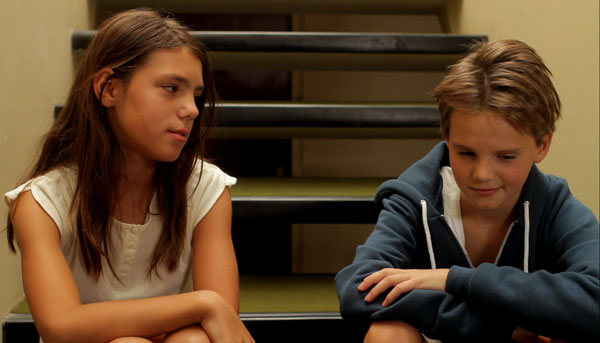
Jeanne Disson as Lisa & Zoé Heran as Laure/Mikael Tomboy_Rocket Releasing © Hold Up Films
As the summer wears on, Laure must go to extreme lengths to maintain her deceit. After a round of soccer, while the boys relieve themselves in an open field, Laure ventures into the woods to squat in solitude. Having found a suitable spot, she looks left, then right, breathing heavily with the anxiety of being caught. When a comrade calls out for Mikael, Laure rises in a panic, her shorts wet with urine. Later, in preparation for a swimming trip, she fashions a fake phallus from green modeling clay. Positioning the prosthesis in her newly truncated swimsuit, Laure examines her profile in the mirror, then gives a wry smile. Though outré, such moments carry a comic air. Tomboy revels not in punishment but in play; its narrative is far from a linear, ponderous plod toward Mikael’s unmasking.
The spaces and textures of childhood furnish Tomboy’s true subject. Sciamma works with her camera low to the ground, capturing her prepubescent subjects straight on, without the angled perspective of a grown-up looking down. Her choice of the Canon EOS 7D, fundamentally a still camera, endows each shot with a strong cinematographic feel: faces and bodies close up stand in sharp focus, while the background is manifest as a blurry spectrum. To the viewer the film feels like childhood, or at least the way we remember childhood: slightly out of focus and vaguely photographic. Save for Laure and Jeanne, all of the children are portrayed by non-professionals, many of them Héran’s friends in real-life: an adept casting choice that imbues their world, however hermetic, with remarkable naturalism. Child’s play — here always imaged in the outdoors — seems to transpire outside of time. The forest, with its spindly trees, muted tones, and soft gobs of sunlight, stands as an imaginary, unspecific place, but here the place of childhood writ large, absent historical markers and social context. Aside from a brief scene where Laure’s father works on a laptop, Sciamma eschews telltale temporal signs: Cultural allusions are spare and speech is neutral, stripped of slangish idiolects.
Though Laure’s predicament is far from generic, Tomboy manages to distill something universal: It paints that moment, poised on the cusp of adolescence, when make-believe can still be guileless. Although abutting her teens, Laure is still very much a child. Her self-structuring as Mikael has an air of casual innocence, and her increasingly amorous interactions with Lisa, free from the complications of pubescent lust, feel simple and sweet, not strained. Laure could easily be flattened into a Freudian case study; the tomboy as psychological type is, after all, penis envy personified. Yet Tomboy’s tone remains light, not peremptory, and its pared-down script abjures analytic jargon. No clear-cut motivation is imputed to Laure’s fashioning herself as Mikael, and Tomboy avoids labels, like “lesbian” and “homosexual,” that might provide one. The film’s sensitive, yet distanced, treatment of its protagonist eludes the heavy-handed interpretation which is all too often the pitfall of work — artistic, literary, and otherwise — on issues of gender and sexuality. Attuned to idiosyncrasy, Tomboy’s portrait unsettles our conventional categories.
]]>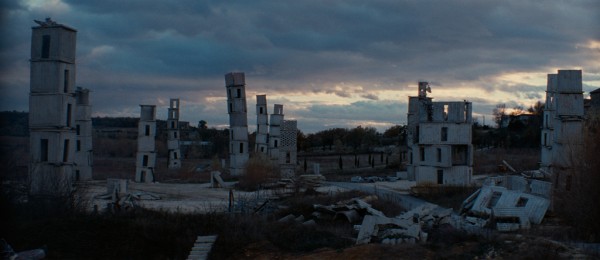
Sophie Fiennes, still from Over Your Cities Grass Will Grow, 2011. Via
In an age where cosmopolitanism is king, Anselm Kiefer has long been hailed as an unapologetically German artist. Born in 1945 to Catholic parents in Western Germany, Kiefer entered a postwar generation haunted by the all-too-recent past. Enrolling in art school nearly two decades after T.W. Adorno’s injunction against poetry, Kiefer grappled with both the inadequacy and the necessity of making art in Auschwitz’s wake. In a 1969 series of photographic self-portraits, Kiefer, clad in Third Reich regalia and arm raised in the Seig Heil, re-enacted Hitler’s “Occupations” of Europe. He has since returned repeatedly to the icons that propelled Nazism’s genocidal “Solution.” To some contemporary critics, Kiefer worked through the psychic repressions of a Germany debilitated by its collective “inability to mourn.” To others, he indulged in the fascination of fascism, employing irony where solemnity was due.
Sophie Fiennes’ film, Over Your Cities Grass Will Grow, documents Kiefer’s latest project, a sprawling complex of buildings, tunnels, and towers erected at La Ribaute, an abandoned silk factory in Barjac, France. Her film provides little context for the artist either Kiefer or his art during its 100-minute run time. The camera delves almost immediately into Kiefer’s Delphic constructions, variously exquisite and oppressive in their aesthetic effects. The artist first appears twenty minutes in, his back turned to the viewer.
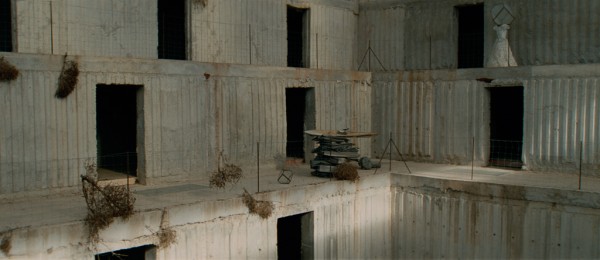
Sophie Fiennes, still from Over Your Cities Grass Will Grow, 2011. Via
Context, however, proves unnecessary. For Fiennes, the true subject is not Kiefer’s biography but the enormity of his artistic vision. La Ribaute’s monumental scale (72 acres, 42 buildings, five assistants); its massive objects (12-foot tall canvases, 600-pound books, 300-ton sculptures); its synthesis of artwork and display space: each evidences Kiefer’s desire to create a Gesamtkunstwerk, or a total work of art. While the museum’s usual scheme of titles, wall labels, and audio guides allows spectators to confront art in pre-digested form, Kiefer’s showrooms resist all interpretive impulses. Absent exegetic markings, save those present in the works themselves, his hermetic compound stands as an anomaly in an art-world eager to tell you where to look and how: a deviance that Fiennes’ film upholds. Here, the only frames provided are Kiefer’s own, voiced in an interview with an eager German journalist. Without a curator’s blurb for guidance, the viewer experiences Kiefer’s work as it was meant to be experienced: directly, elementally, and bluntly.
In abstaining from comment, Fiennes’ film proves documentary in the most literal sense. Moving through La Ribaute’s spaces as would a curious visitor, Fiennes’ camera observes and refuses to prescribe. With long, steady takes, she traverses the subterranean rooms and above-ground galleries of Kiefer’s compound. What we see is a landscape in ruin, littered with detritus and dust, devoid of all but traces of a long-gone human presence. Illuminated alternately by solitary bulbs and floods of natural light, Kiefer’s constructions are allowed to stand as they are: some confined, others towering in scale. Here, the haunting dissonances of György Ligeti, a postwar Hungarian composer and Kubrick favorite, take the place of pedantic analysis. These spaces and the artworks they contain arrive raw, unfiltered by the critic’s compulsion to explain. Paired with the drama of Ligeti’s score, La Ribaute’s complex layering of art and architecture provokes an intense emotional response.
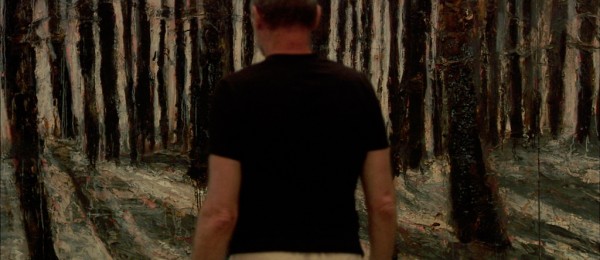
Sophie Fiennes, still from Over Your Cities Grass Will Grow, 2011. Via
The film’s sparseness may frustrate some viewers, as Kiefer’s oeuvre nearly begs for annotation. Equal parts esoteric and expansive, his references flow from some storied elsewhere that bears scant resemblance to the present. As Kiefer has said point-blank, “My work is never about today.” Motifs from Teutonic lore, Lurianic messianism, Jewish mysticism, Old Norse poetry, Babylonian texts, and Oriental mythology recur obsessively in his art. In the film, Kiefer jumps from a meditation on Jason, leader of the Argonauts, to the sephiroth of Kabbalistic creation myth. He mentions 16th-century polymath Robert Fludd in passing and recounts Heidegger’s lectures on boredom, then turns to quantum physics. He scrawls the Hebraic name “Schechina” across the top of a canvas, pencils the digits one through ten on a stiffened white dress, and shouts “Bonjour Tristesse!” while throwing plates of glass in his flip-flops. Each moment attests to Kiefer’s profound idiosyncrasy and the intensely personal nature of his iconography. Tracing the tenuous lines of convergence that unite his work, Kiefer’s spectator must leap across cultures and epochs with no guarantee of finding stable ground.
Traditional artists’ tools of easel, palette, and acrylic color have no place in Kiefer’s process. His tonal range admits of nothing artificial: only grays, ochers, and the red of actual rust. He works with his canvases on the ground, alternately stepping on their surface and exposing them to an array of unorthodox substances. He instructs his assistant to hurl dirt at a freshly painted canvas and drip acid on a suspended metal book. He heats lead with a blowtorch and pours the product down a pile of contorted concrete. He sets books ablaze with stunning salmon and lavender flames, then rakes their soft ashes. Glass, clay, and ceramics are broken to spectacular effect, variously flung down hallways and toppled onto the floor, while the artist’s other materials of choice — straw, concrete, and standing water — prefer to aggregate en masse. Fiennes’ skillful edits contrast the violence of Kiefer’s acts of shattering, blanching, and scalding with the passivity of the monuments he produces.
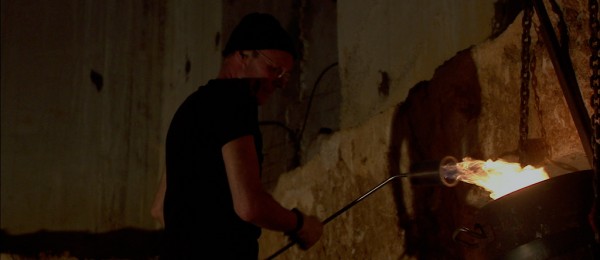
Sophie Fiennes, still from Over Your Cities Grass Will Grow, 2011. Via
With a predilection for industrial materials comes a need for industrial machinery. As repeated shots of bulldozers and dump trucks remind us, La Ribaute is at once an art studio and a construction site. Fiennes lavishes screen time on excavators excavating, cement mixers mixing, and forklifts lifting—often for stretches of four minutes or longer. These banal moments trail some of the film’s most evocative sequences. Fiennes scans a three-story bookshelf filled with weathered lead volumes, jagged shards of glass, and abstruse cursive script, then cuts to a long shot of one of Kiefer’s assistants stoking a furnace. She tracks through a vaulted archive cluttered with filing cabinets and half-finished paintings; as she turns the corner, plates fly from some hidden space behind the camera, bursting as they meet the ground. The ensuing shot: a close-up of a drilling machine.
Far from arbitrary, Fiennes’ direction illuminates the tension between Kiefer’s mundane media and its sublime effects. His materials and tools are pedestrian, the stuff of assembly lines and scrap heaps. The geographies he renders — high-horizon landscapes of oceans, forests, and plains — are similarly familiar. Names like Lilith and Josiah ring with Biblical charge: we feel like we’ve heard them before. Yet, in the context of La Ribaute, the commonplace gives way to the uncanny. A multi-ton sculpture comprised of undulating concrete, exposed reinforcing rods, and a shipwrecked boat conjures numerous associations: the Great Flood, the Berlin Wall, and some primordial catastrophe. The multiple meanings evoked exceed our ability to apprehend them. Outward accessibility yields to a profound elusiveness. Objects, materials, and themes that have been seen before now appear strange.
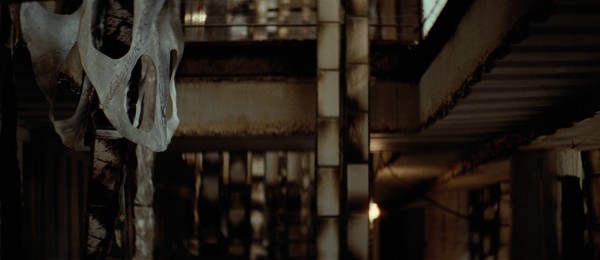
Sophie Fiennes, still from Over Your Cities Grass Will Grow, 2011. Via
So unsettled, the art acquires a visceral quality. Kiefer, indeed, is no allegorist in the traditional sense, à la Rubens or Bruegel. No obdurate rules govern the relationship between his representations and their ostensible subjects. Neither illustrative nor literal, his paintings are not one-to-one mappings from myth to canvas, nor do they purport to be. While Kiefer’s looping cursive and comments throughout the film hint at a certain depth of meaning, precise articulations are always deferred.
Critics frequently analogize Kiefer to an archaeologist, excavating the ghosts of a Germany still paralyzed by its past. The project at Barjac, however, shows him to be just the opposite. While an archaeologist uncovers, clarifies, and constructs wholes from fragments, Kiefer buries, obscures, and revels in disintegration. Close-ups of his canvases reveal a series of sedimented layers, each the product of numerous ruminations and textures. Strewn over the floor of his cavernous warehouse, Kiefer’s paintings engender new and ever-more oblique associations.
Making sense of La Ribaute thus becomes a somewhat absurd task, as the artist readily admits. Speaking to an assistant, he describes the Kabbalists’ ability to generate symbolism from arbitrary markers—the number of words in a text, for instance—as verging on farce. “It becomes completely ridiculous,” he exclaims. “It doesn’t make any sense anymore, but they like this.” The same could be said of Kiefer. Fiennes shows us an artist whose rhythms are cyclical and whose process is unplanned. When a German interviewer refers to a page of Kiefer’s lead tomes as “empty,” the artist retorts: “It’s not empty. It contains everything.” Hopelessly overcoded, Kiefer’s production is now too vacant, now too full.
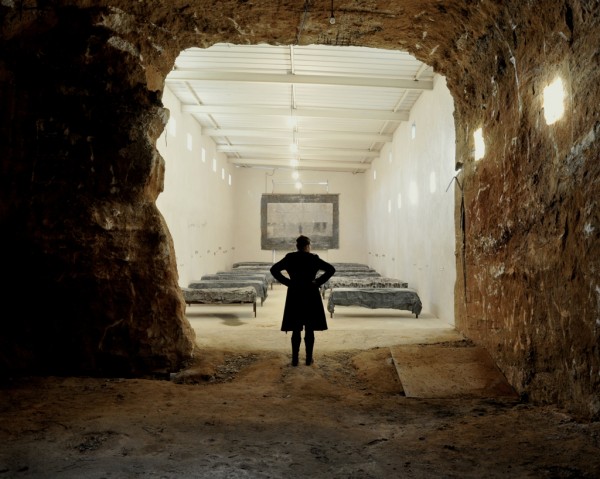
Remco Schorr, Sophie Fiennes on location, 2008. Via
This idea of deferred or irrecuperable meaning undergirds Kiefer’s project. Tracking slowly through La Ribaute, the film’s viewer cannot help but experience a sense of loss. Take, for example, Fiennes’ extended shots of Kiefer’s oversized lead books. Some are stacked on lofty shelves entangled in wire; others are piled on the floor, sandwiched between slabs of cement, shards of glass, and desiccated poppies. While most are closed, some display pages oxidized in a range of watery grays, absent any text. Belying their conventional raison d’être (namely, to be read), these books furnish the foundation for a series of looming towers, captured poignantly in the film’s final shots. As cranes lower L-shaped blocks of concrete over these volumes, the inaccessibility of their words becomes clear. Crushed under concrete and their own weight, the texts stand not as repositories of knowledge acquired, but as reminders of wisdom lost. Coupled with Fiennes’ survey of La Ribaute’s desolate interiors, these books inspire a distinct melancholy. History, Kiefer seems to say, is nothing but a succession of irreparable losses and catastrophes. As the artist put it himself, “Auschwitz, unfortunately, does not preclude other Auschwitzes.”
It follows that Kiefer’s artistic endeavor has been defined as a “project of mourning,” though the object of loss has shifted over the course of his career. In the 1970s, with his somber renderings of fascist architectures and reconstructed genealogies, Kiefer mourned his native Kultur, now contaminated by Fascism. In the early 1980s, he turned to the Third Reich’s Jewish victims in his series of Margarete and Shulamith canvases, based on Paul Celan’s famous “Death Fugue.” With La Ribaute, however, Kiefer pursues something more universal. Midway through the film, after explaining man’s most primal yearning—to return to the “warm sea” whence he came — Kiefer laments his inability to “reach the core,” that basic principle that “holds the world together.” Elsewhere, he has spoken of a “layer behind,” which, if he could only access it, would enable him to stop painting. The loss grieved at La Ribaute, then, is our inability to know our origins, to reach an ultimate synthesis of meaning and discern “the core.” Tellingly, Kiefer’s intricate iconographies fail to produce a grand rècit. Their constellations of meaning remain as opaque as the compound’s ubiquitous lead tomes. For Kiefer, the whole is impossible: if they are to exist at all, all things — glass, lead, concrete, clay — must exist as fragments.
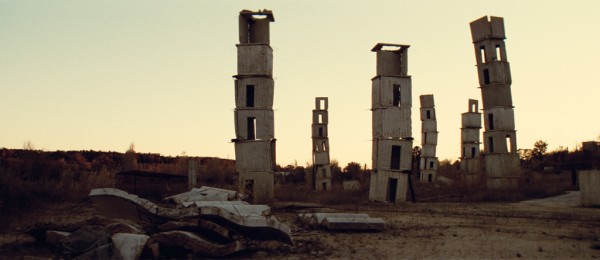
Sophie Fiennes, still from Over Your Cities Grass Will Grow, 2011. Via
Fiennes’ refusal to interpret, to allow anyone to discuss Kiefer’s work except Kiefer, is thus crucial to the success of her film. Erudite expositions that pin each pictorial reference to a textual source miss the point. In Kiefer’s oeuvre, tension and paradox reign, and the artist delights in both, masterfully juxtaposing the ponderous and the brittle, the rigid and the soft. La Ribaute works precisely to the extent that it fails to map its own labyrinthine allusions. Alert and unobtrusive, Fiennes’ camera performs a comparable feat, ringing these ambiguities without explicitly spelling them out. Subtle, delicate, and affecting, Over Your Cities Grass Will Grow captures Kiefer’s complexity enough to show just how much it is we’re missing.
]]>